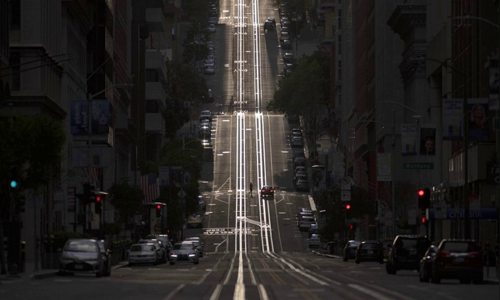It is difficult for the United States to impose a blockade such as China or South Korea, forcing it to choose a "community separation" solution to prevent Covid-19.
The first case of nCoV was discovered in the United States on January 20, the patient was a man who returned from Wuhan and landed at Seattle International Airport. The new infections later appeared rather slowly, but started to skyrocket after about two months.

The social isolation plan to control Covid-19 in the United States Photo: AFP
The US currently records more than 9,000 cases of nCoV, of which 150 people have died, an increase that is causing many experts to worry. If the number of nCoV-positive people doubled every three days, the US would face 100 million virus infections in May.
The rate of new infections could be slowed if Americans take the "community isolation" approach, avoiding crowded public places and minimizing travel. This is considered the most effective method to control Covid-19 in the US, compared with Chinese city blockade or large-scale and localized testing in South Korea.
The Washington Post of the US simulated infectious disease control options in a 200-person community. The brown dot represents the infected person, the blue color is the healthy one and the pink color is the recovered patients.
The disease is called "simulitis" and is more likely to spread than Covid-19, which can spread the virus and make healthy people infected right after first exposure. Recovering patients will not be able to transmit the virus, nor will they be re-infected if exposed to another patient.
In the absence of control, the number of people infected with simulitis quickly soared and peaked, leaving the whole community infected. The graph of an infected person only begins to go down when a patient recovers. This process will take much longer in large residential areas.
The community blockade effort similar to China has not been thoroughly effective because the US isolation barriers still leave people ill. The US government also did not collect and publish the personal data of people who are virus-positive like in South Korea, making it difficult to track patients and localize infections.
"Many people work in the city and reside in the suburbs or vice versa. Are they willing to separate from the family? How to block all roads and ensure essential supplies for the people", Leana Wen, a former Baltimore city health official, explained why urban isolation is not feasible in the United States.
"The fact is that the blockade is rarely used and is difficult to work," said Lawrence O. Gostin, a professor of health law at Georgetown University.
This has led to a "community gap" solution, in which health officials encourage people to avoid crowding, staying at home more and keeping distance from those around them. If people restrict their movement and avoid contact, the virus has less chance of spreading.
Some people will still leave home, either because they have to work or are required to do so, as well as refuse to issue warnings from local officials. This group of people is not only susceptible to disease but also the largest source of infection in the community.
The rate of infection will be significantly reduced if 75% of the population carry out "community isolation". Officials can encourage this activity by closing places that attract people.
"We can curb the desire to gather by closing public spaces. Every restaurant in Italy has ceased operations. China has frozen all locations, and the US is starting to close many places. Cut out." reducing focus opportunities will help people maintain community isolation, "said Drew Harris, a public health researcher.
In the final test, the researchers increased the proportion of people who restricted movement to 87.5%, simulating a "radical community gap" situation. Simulitis is under control and almost no longer contagious.
"Simulitis is not Covid-19, these simulation experiments also simplify a lot of real-life complex factors. However, it shows that a person's actions can cause propagation effects and effects. even unrelated people, "commented Harry Stevens of the Washington Post.
An important factor not included in the trial was mortality. Simulitis is not deadly, while Covid-19 has caused nearly 9,000 deaths worldwide.
"If you want this experiment to be more realistic, some cases should disappear from the simulation map," says Harris.



 MickOmertaChinchio
MickOmertaChinchio







